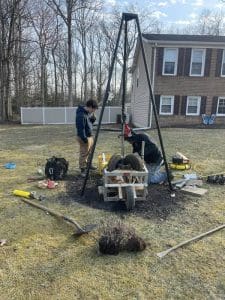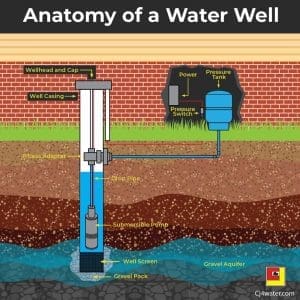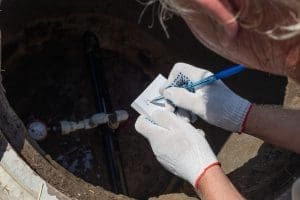 A healthy water well provides clean, safe water for families and farms nationwide. Healthy water wells keep out sediment, dangerous toxins, and bacteria that can harm humans or animals. Southern Maryland has a shallow water table and porous, sandy soil in many areas, particularly along its coastal regions. These characteristics allow contaminants to reach groundwater more easily than in areas with deeper or less permeable soils. Plus, much of Southern Maryland is rural and agricultural. Fertilizers, pesticides, and manure from farms can leach into groundwater, resulting in elevated levels of nitrates, coliform bacteria, or other chemical contaminants in well water. To ensure a healthy water well, people have to test wells, repair broken components, and apply appropriate filters.
A healthy water well provides clean, safe water for families and farms nationwide. Healthy water wells keep out sediment, dangerous toxins, and bacteria that can harm humans or animals. Southern Maryland has a shallow water table and porous, sandy soil in many areas, particularly along its coastal regions. These characteristics allow contaminants to reach groundwater more easily than in areas with deeper or less permeable soils. Plus, much of Southern Maryland is rural and agricultural. Fertilizers, pesticides, and manure from farms can leach into groundwater, resulting in elevated levels of nitrates, coliform bacteria, or other chemical contaminants in well water. To ensure a healthy water well, people have to test wells, repair broken components, and apply appropriate filters.
The following article outlines the steps to take to ensure a healthy water well system.
Key Takeaways on Maintaining a Healthy Water Well
- Routine testing and inspection of your water well is imperative when it comes to protecting your family’s health and avoiding waterborne diseases, particularly if you live in rural or semi-rural America.
- Regular care of your well and plumbing system increases the longevity of pipes and appliances, ultimately saving you money on repairs and energy bills.
- Recognizing sensory indicators, such as changes in a well’s taste, odor, or appearance, can help detect contamination early, protecting both your home’s value, your health, and your healthy water well.
- Knowing what contaminants are local, such as agricultural runoff, heavy metals, and naturally occurring minerals, allows for proactive measures to be taken in source protection and community education.
- Well stewards should record, test annually through certified labs, and visually inspect well equipment and surroundings to safeguard sources and ensure you have a healthy water well.
- When in doubt or when conditions change significantly in terms of water quality or pressure, consult a licensed professional to ensure you’re up to code and have a reliable, healthy well water source.
Why a Healthy Water Well Matters
 A healthy water well is not just a well—it’s a pillar for the health, safety, and well-being of your home. Here in the United States, private wells are prevalent in rural and semi-urban areas, so maintaining a well in good shape becomes critical for dependable, secure water daily.
A healthy water well is not just a well—it’s a pillar for the health, safety, and well-being of your home. Here in the United States, private wells are prevalent in rural and semi-urban areas, so maintaining a well in good shape becomes critical for dependable, secure water daily.
Below are key reasons why ongoing well health is so important:
-
By mitigating the risk of waterborne illnesses and chemical exposure, it safeguards household health.
-
Extends plumbing life by reducing sediment, rust, and mineral deposits.
-
Energy savings – helping your appliances run more efficiently with clean water.
-
Protects your property value — leaves your home more marketable and more secure to prospective buyers.
-
Gives you peace of mind, knowing your water source is secure and reliable.
1. Your Family’s Health Depends on a Healthy Water Well
Testing your well water regularly helps catch harmful contaminants early. Among them are bacteria, heavy metals, and nitrates, which can cause critical health conditions when ingested over time.
For families, it is safe drinking water. Bad water can mess you up kidney-wise, stomach-wise, or even cause cancer in extreme instances. Easy measures, such as annual testing, installing adequate filtration, and installing a water treatment system can avert these dangers.
Ensure that everyone at home, particularly the younger ones, understands why healthy water is essential. Even toddlers should be educated to avoid sucking from mysterious streams and sludge-covered spigots. Babies require extra care, as elevated nitrates can be deadly to them far sooner than to an adult.
2. Your Plumbing’s Lifespan Depends on a Healthy Water Well
Regular maintenance can detect leaks or rust before they become expensive fixes. These drips not only waste gallons of water, but can also cause pipes to rust and weaken.
Furthermore, installing your plumbing with a solid material, such as copper or black poly helps prevent rust and pipe bursts. Maintaining consistent water pressure saves your pipes and joints from strain and premature wear.
With a bit of routine maintenance, such as flushing the system and checking for buildup, you can add years to your plumbing’s life and reduce the frequency of emergency calls.
3. Your Appliance Efficiency is Increased with a Healthy Water Well
When you run filtered water through washing machines and dishwashers, they operate more efficiently and last longer. Sediment and minerals from raw well water can clog components and strain equipment, increasing your bills.
Regular maintenance helps prevent scale and deposits, particularly in areas with hard water. Replacing old appliances with eco-friendly models can save energy and costs year after year, contributing to clean water systems.
4. Your Property Value is Higher with a Healthy Water Well
A beautiful water well attracts buyers who need a healthy and dependable water supply. Providing evidence of water testing or routine well maintenance can give buyers peace of mind regarding the long-term safety and quality of the property.
Addressing any water quality concerns sooner rather than later prevents them from eroding your home’s value. Moreover, they can be documented from certified inspections to increase trust and confidence when selling. Dependable water is a good long-term investment.
5. Your Peace of Mind with a Healthy Water Well
Testing your well on a regular schedule enables you to identify hazards and correct them promptly.
A well-maintained plan ensures water safety, and surprises are rare. Local water reports can warn you of new dangers. If you have a flood or chemical spill plan, you’re prepared for anything.
Signs of a Compromised Well
A healthy private well produces pure, safe drinking water free of unusual tastes, odors, or discoloration. When the home water treatment system is compromised, the signs show up in the water itself, in plumbing behavior, health symptoms, or even your utility bill. In the Bay Area and most of California, well water is vulnerable to natural minerals such as arsenic or radon, as well as contaminants from septic or old fuel tank leaks. Recognizing the tell-tale signs of a compromised well is crucial in protecting your water safety.
Sensory Clues
Bad smells, such as a rotten egg smell, can indicate the presence of gas-producing bacteria in your well. If your tap water smells earthy or metallic, it may indicate chemical or mineral contamination, typically resulting from runoff or soil seepage in the local geology.
Yellow, brown, or cloudy water generally indicates the presence of sediment, rust, or organic material. Cloudy water can appear following heavy rains or construction in the area, indicating that the ground surrounding your well has been agitated.
Colored staining on your sinks, tubs, or laundry, such as brown, red, or blue, can indicate the presence of excessive iron, manganese, or copper. Odd or bitter tastes, such as those that are salty, metallic, or chemical, should never be overlooked. They can indicate farm runoff, pesticides, or naturally occurring high minerals.
Odd flavors require immediate testing and, if necessary, treatment. Loss of water clarity–water that’s no longer clear, even for a short time–indicates potential contamination. Even a minor shift following a storm or earthquake movement in the vicinity of your well calls for fast action.
Plumbing Issues
Slow drains or regular clogs can be caused by sediment buildup in pipes, not just the well. When minerals or silt enter your plumbing, they can clog the flow and compromise water quality.
Leaks around faucets and pipes spell doom. They waste water, increase your bills, and produce damp areas that foster mold growth. Look for mysterious wet spots beneath sinks or at the base of fixtures.
Low water pressure is a traditional warning signal. If your shower or tap is spitting out less water than usual, it could be due to issues with the well pump, pipes, or even the well itself. Abrupt variations in water flow, such as a decrease or increase in pressure, may indicate a malfunctioning well pump or groundwater depletion, conditions that could compromise water quality.
Health Symptoms
- Nausea, vomiting, or diarrhea
- Skin rashes or irritation
- Stomach cramps
- Unusual fatigue or headaches
Watch for unexplained fatigue or headaches after consuming well water. Specific contaminants induce moderate symptoms, whereas others, such as elevated nitrate levels in infants, can be fatal.
If you or your family become ill after consuming well water, contact your doctor immediately. Tell them you have a private well. Educate all members of your household on how to detect symptoms of waterborne illnesses, particularly children and the elderly.
What Contaminates Your Water
Well water in the United States can contain a mixture of contaminants, which may originate from the earth itself or human activities in the surrounding area. For private well owners, understanding what contaminates your drinking water is crucial for maintaining a safe drinking water source.
-
Bacteria and viruses can seep into wells, primarily in shallow configurations or following substantial rainfall. Microorganisms enter from leaking septic tanks, runoff, or animal yards.
-
Nitrates, often from fertilizers, can accumulate in the soil and leach into the water, presenting health concerns, particularly for infants.
-
Lead and other heavy metals can enter from old pipes or naturally occur in local rocks and soil.
-
Volatile organic compounds (VOCs, such as benzene and chloroform) can be found near industrial sites or areas with pesticide use.
-
Arsenic and radon, both of which are naturally occurring in some areas of the U.S., can be harmful if consumed in high amounts.
-
Run-off from rain, flooding, or melting snow can bring surface contaminants directly into shallow wells.
-
Storage tanks, underground fuel tanks, and landfills can leak, allowing contaminants to leach into groundwater.
-
Animal feedlots, manure stacks, and failing septic systems near wells increase the chance of water contamination.
Natural Sources
Minerals such as iron, manganese, and occasionally arsenic can leach into well water from soil and rock. The danger is a function of local geology. In certain areas, such as California and the Midwest, arsenic and radon levels are elevated due to the type of underground rock.
Intense rain or drought alters groundwater flow, transforming what contaminates your water. For instance, after a storm, runoff may shove more minerals or bacteria into private wells. Drought tends to concentrate minerals.
Additionally, natural features such as a river or lake near your property can affect what seeps into your water well. Water rises and falls, affecting the way surface water and groundwater in the vicinity intermix.
Human Activity
Agricultural runoff is a leading source of well contamination. Fertilizers, manure, and pesticides in fields leach through soil and into groundwater. This is typical of any farming region.
Septic tank leaks, old landfills, or underground fuel tanks can leak bacteria, nitrates, and chemicals. If your well is near these, the hazard increases. Animal feedlots and manure piles in the vicinity increase the likelihood that bacteria will contaminate your water.
Industrial labor and city runoff are significant issues in and around urban areas. Factories and warehouses can leak VOCs and heavy metals. Road or parking lot runoff deposits oil, lead, and debris into the earth. Innovative land use, such as siting wells away from pollution sources, helps safeguard your water.
Staying Informed on Issues of Maintaining a Healthy Water Well
Consult local environmental reports to identify common contaminants in your region.
Chat with neighbors and specialists. Connect with local water groups to receive and provide updates.
Test your well frequently. Use certified labs and document it.
Seek assistance if you notice any alterations in the flavor, odor, or appearance of your water.
Your Role as a Well Steward: Healthy Water Well
To be a good steward in America is to take initiative in caring for your water well. Your role spans regular monitoring, sampling, source protection, and public awareness. It’s a hands-on position that requires attentiveness, engineering expertise, and dedication to community well-being.
Below are key duties for a good steward in maintaining a healthy water well.
- Let’s check the well location. Be sure it’s upslope from any pollution sources.
- Examine your well casing, cap, and surrounding ground for defects and hazards.
- Plan and record periodic water quality analyses by certified laboratories.
- Maintain the well apron and the immediate site free of waste or chemicals.
- Follow the three R’s: reduce, reuse, and recycle water for a sustainable supply.
- Make sure that the well casing protrudes at least 2 feet above flood level.
- Be aware of local laws. Underground water pollution is against the law, regardless of whether it’s caught or not.
- Arrange for professional maintenance every 10–20 years.
- Learn and teach well stewardship and hazards.
Routine Testing
 Annual water quality testing is a crucial practice. You need to test for bacteria, nitrates, and other invisible threats that may represent genuine health hazards. You should test before using a new well or following significant storms, floods, or nearby construction, as these situations can quickly shift groundwater quality.
Annual water quality testing is a crucial practice. You need to test for bacteria, nitrates, and other invisible threats that may represent genuine health hazards. You should test before using a new well or following significant storms, floods, or nearby construction, as these situations can quickly shift groundwater quality.
Certified labs give you accurate results. Track outcomes annually to identify patterns and respond to emerging threats. Tracking your records means you can be the judge of when a change is organic or warrants attention.
If results indicate an issue, address it with the proper treatment or repair. Being proactive can be cost-effective and help protect the water resources we all rely on.
Visual Inspections
Invest less than 30 minutes every season walking around your well. Inspect for casing cracks or damage, as such imperfections allow dirt, insects, or chemicals to infiltrate. Inspect the base for puddling or erosion—each signal of drainage or seal problems that require fast repairs.
If you notice plants sprouting immediately adjacent to the well, eliminate them. Roots can fracture the casing or cap, resulting in expensive repairs. Your well cap should remain secure and intact to prevent debris and pest intrusion.
Well, craftsmanship counts; your well should last 50 years or even longer with proper care.
Source Protection
Create a buffer of at least 50 feet between your well and septic systems, barns, or chemical storage areas. This protects against runoff and spills—exchange best practices with neighbors, particularly if you all tap the same aquifer.
Dispose of waste responsibly. Never dump oil, paint, or chemicals near the well. Do your part, pay your fines. Be vigilant—medium-risk habits might not be enough if risks escalate.
Education and Awareness on a Healthy Water Well
Educate your family, friends, and neighbors on why well care is essential. Pass on your knowledge to quick inspections and warning signs.
Reinforce with others that guarding a well is the law, not merely good sense.
The Unseen Connection
A good, healthy water well is not just a hole in the ground – it’s part of a system that takes water from its source and distributes it throughout the home. Water then runs from the well, through pipes, gathers whatever it can from the pipes, and finally drops into glasses, cooking pots, and appliances. Clean delivery is significant because everything that happens along the way influences water quality and, subsequently, one’s mind and body.
It’s this unseen connection between the source, pipes, and point of use that makes hydration safe and effective.
Well to Faucet
Water runs from the well to our taps in a system of pipes, valves, and fixtures. If any fixture is not installed correctly or leaks, impurities can sneak into the water supply, or pressure can decrease. Regularly checking for drips or corrosion at joints can prevent minor issues from becoming expensive repairs.
A faucet filter can additionally reduce any particles and microorganisms that may pass through previous stages. This step is crucial because even clean well water can still pick up metals or bacteria from aged pipes. Cleaning faucet aerators is a fast method to prevent mineral buildup, which can restrict flow and capture contaminants.
If water pressure decreases, it could indicate debris accumulation in pipes or a pipe leak, both of which endanger water purity. Watch, wipe, and dry these points, and you keep the water secure and stable.
Well to Appliances

Woman checking her damaged washing machine, the floor is flooded
Your daily staples—dishwasher, washing machine, water heaters—all rely on that same water you drink. When water transports sediment or minerals, it can clog hoses, erode internal components, or potentially reduce an appliance’s longevity. Regular upkeep, such as cleaning filters or performing cleaning cycles, maintains efficiency and prevents premature failures.
Placing a filter on the front end can prevent larger intrusions from reaching the equipment. This reduces the potential for scale buildup and increases appliance life. Training the entire family to use these appliances correctly — loading washers evenly and operating them with the proper settings — maintains efficiency and reduces stress on the water system.
Hydration and Mental Clarity
Hydration is more than just a corporeal desire. The brain is roughly 73% water; therefore, even mild dehydration can make it hard to concentrate or amplify stress. When stress accumulates or schedules get hectic, we forget to drink.
A consistent stream, that’s some untainted flow, is what makes us feel steady. Mental exhaustion often stems from low-hanging fruit, such as not drinking enough water from a healthy water well, particularly when you rely on well systems that require extra care.
Clean Pipes, Clear Mind
Sparkling pipes in a home water treatment system keep drinking water clean. Regular maintenance of private wells catches trouble early, ensuring safe drinking water from a healthy water well that heals both body and spirit.
When to Call a Professional
Water well owners in the U.S. should know when to contact a licensed contractor or water system professional. If you observe significant shifts in water quality, such as peculiar taste, odor, or discoloration, it’s unwise to delay. These shifts can indicate bacteria or other nasties have found their way into your water.
Occasionally, water pressure loss is the initial indication of a problem with your pump or pipes. If your water suddenly slows or stops, or you hear unusual noises from the pump, call a professional. Don’t fix it yourself if you’re not sure what’s wrong. Well systems are tricky, and a small screw up can exacerbate the situation and have a negative impact on your healthy water well.
Flood-prone spots require special attention. If your well rests in a depression where water collects after storms, a professional should elevate the well casing. Professionals should ensure it is a minimum of a foot above the highest known flood line. It helps keep the grimy water out.
If your well casing appears cracked or your pump seems to be malfunctioning, have a professional inspect it. Even tiny cracks can introduce surface water, resulting in significant issues, such as the presence of E. coli or other contaminants.
Annually, a pro should inspect your entire well and pump system. We’re talking a full six-point inspection—testing for bacteria, water flow, pressure tank, and more. The pressure tank should be replaced every decade, at the latest, and that work is best reserved for someone equipped with the proper tools.
Routine testing helps keep your water safe and can detect problems early. If you suspect your water may be contaminated, or you notice debris, sand, or particles in it, a plumber or well contractor can test for bacteria and chemicals.
If you’re selling your house or if new rules have been implemented in your city, a professional can help you ensure everything meets local codes, and you have a healthy water well. They are familiar with the regulations for your region and can assist you in keeping your well up to date.
Don’t know what’s wrong or how to fix it? Save the time and stress and call somebody who knows wells! Attempting to seal things up by yourself can do more damage than repair, particularly with pumps and pressure tanks. These important components all have an impact on a healthy water well.

Conclusion
To keep your healthy water well, listen attentively, respond promptly, and recognize the symptoms. A healthy water well provides comfort and clean water time after time. It’s the little things that count–a loose cap, rust on fittings, or a cloudy water can spell disaster. Catch these bugs, and you save time and money. Dry spells and runoff introduce new dangers in places such as California. Be smart, know yourself well, and don’t hesitate to call a professional if things appear amiss. Healthy water should never be a guess. Own it, master the fundamentals, and connect with local professionals. For those who want to dig a little deeper, check out county guidelines or discuss with your well-having neighbors.
Frequently Asked Questions about Maintaining a Healthy Water Well
What makes a healthy water well?
A healthy private well provides clean, safe drinking water free from harmful germs and contaminants. Regular testing and maintenance by a licensed well contractor will keep your home water treatment system in tip-top shape, and you will have a healthy water well.
How can I tell if my healthy water is unsafe?
Taste, odor, or color changes in your healthy water well can be red flags for private well owners. If you notice cloudy water or become ill after drinking, your private well may be in danger.
What are common well water contaminants in Southern Maryland?
Typical contaminants in private wells include bacteria, nitrates, pesticides, and heavy metals such as arsenic, often due to runoff and the presence of old pipes. Again, this has a negative impact on your healthy water well.
How often should I test my healthy water well?
Check your private well water annually for contaminants like bacteria and nitrates, ensuring safe drinking water for your home.
What should I do if I suspect well contamination?
Quit drinking and cooking with the well water; contact a licensed well contractor immediately for testing and repairs to ensure safe drinking water and to maintain a healthy water well.
How can I protect my well from contamination?
Don’t let chemicals and waste seep around the private well. Ensure that your well cap is secure and intact for safe drinking water. Plan regular inspections.
When should I call a professional for my well?
If you notice changes in water quality, reduced flow, or flooding near your private well, call a pro. This could have a negative impact on a healthy water well. Annual inspections by a licensed well contractor help ensure the safety of drinking water and prevent potential issues.



0 Comments